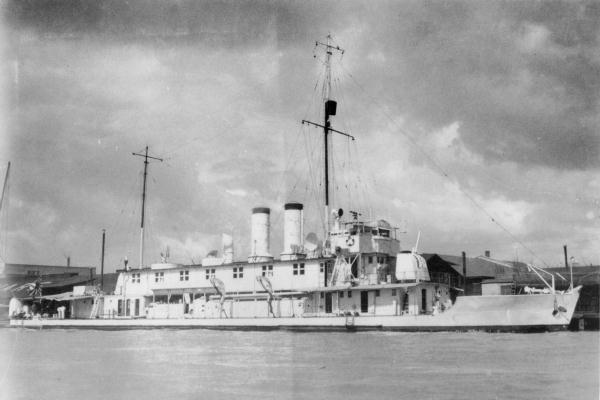©2010-2015 Bob Hackett and Sander Kingsepp
Revision 1
15 August 1921:
Kobe. Laid down at Mitsubishi Zosensho.
9 April 1923:
Launched and named HOZU. .
September 1923:
Completed. Disassembled and shipped to Hangkow, China. [1]
September1923:
Reassembled and completed at Yangtze Engineering Co. Hangkow. HOZU departs heading up river.
4 October 1923:
Hankow. British insect class river gunboat HMS COCKCHAFER is at anchor. At 0545, her crew logs that she is passed by IJN HOZU heading up river.
29 November 1923:
Ichang (now Yichang), China. HMS COCKCHAFER anchors accompanied by gunboat HMS CRICKET. HOZU's captain pays a courtesy visit to HMS COCKCHAFER. At 1400, HOZU is visited in turn by
HMS COCKCHAFER’s captain.
1 May 1927:
LtCdr (later Rear Admiral) Hori Yugoro (41) is appointed CO.
30 November 1929:
LtCdr (later Vice Admiral) Kamata Michiaki (39) is appointed CO.
1 December 1930:
An unknown officer is appointed CO.
8 September 1931: The "Mukden Incident":
Liutiaohu, about 25 miles
from Mukden (now Shenyang), the capital of Manchuria. Japanese soldiers detonate
an explosive on the Japanese-owned Southern Manchurian Railway. Chinese soldiers
retaliate with gunfire. The Japanese Kwantung Army reinforces their troops and
settles the conflict. The Japanese continue N to Mukden, attack the city and win
control the next day. The “Mukden Incident” is the beginning of the Pacific War.
1 November 1933:
LtCdr (later Rear Admiral) Nagai Mitsuru (45) is
appointed CO.
15 May 1934:
LtCdr (later Rear Admiral) Nakatsu Seiki (44)) is
appointed CO.
15 November 1935:
An unknown officer is appointed CO.
7 July 1937: The Marco Polo Bridge (The"First China Incident") Incident:
Hun River, Lukuokiao (Peking), China. Japanese troops at the bridge fire blank cartridges during night maneuvers. Chinese troops fire back. Later, the Japanese discover a soldier missing. They demand entry to the Peking (Beijing) suburb of Wanping to look for him, but the Chinese refuse. The Japanese shell the city and an undeclared war on China begins.
July 1937:
Japanese residents in the Yangtze River area are guarded by
Rear Admiral (later Vice Admiral) Tanimoto Umataro’s (35) 11th Gunboat Division
composed of flagship minelayer YAEYAMA, HOZU, river gunboats FUTAMI and KOTAKA
and a detachment of 292 troops of the Shanghai Special Naval Landing Unit, all based at Hankow.
29 July 1937:
The Japanese capture the ancient Imperial Chinese capital of Peking (now Beijing).
July-early August 1937:
The 11th Gunboat Division evacuates Japanese civilians from the interior to Shanghai.
13 August 1937: The Second Battle of Shanghai
Shanghai. At 0900, more than 10,000 Japanese troops enter the suburbs. Fighting begins in the Zhabei, Wusong and Jiangwan districts. ATAKA and the 11th Gunboat Division put ashore Special Naval Landing Force (SNLF) reinforcements. At 1600, warships of Vice Admiral (later Admiral) Hasegawa Kiyoshi’s (31)(former CO of NAGATO) 3rd Fleet in the Huangpu (Whangpoa) and Yangtze Rivers begin bombarding Chinese shore positions.
14 August 1937: "Bloody Saturday":
Shanghai. Flagship USS AUGUSTA (CA-31), carrying Admiral Harry E. Yarnell (former CO of SARATOGA, CV-3), CINC, U.S. Asiatic Fleet, arrives from Tsingtao and anchors in the Huangpu River. That same day, the Chinese Air Force (CAF), under retired Captain (later LtGen) Claire L. Chennault, launches aircraft to attack IJN flagship IZUMO and the Japanese fleet. The CAF mistakenly bombs British cruiser HMS CUMBERLAND, but their bombs fall wide. Two bombs also fall close alongside AUGUSTA, but no one is killed. Other CAF fliers also bomb Shanghai city, killing more than 1,700 civilians and wounding 1800 others.
19 August 1937:
In view of the increasing danger, it is decided to repatriate Shanghai’s Japanese women and children. About 20,000 of the total 30,000 residents are successively returned home.
23 August 1937:
50 km NE of Shanghai. The IJN lands General Matsui Iwane's 3rd, 8th, and 11th Divisions at Chuanshakou, Shizilin, and Baoshan under the cover of the 3rd Fleet's guns. The IJN also makes other large-scale landings of Matsui's troops at Liuhe, Wusong and Chuanshakou.
25 October 1937:
Chinese troops begin withdrawl from parts of Shanghai.
5-12 November 1937: - The Fall of Shanghai:
S of Shanghai. The IJN lands the IJA 10th Army in Jinshanwei, nearly unopposed. On 8 November, Generalissimo Chiang Kai-shek issues an order for a general retreat. By 12 November, Shanghai is cleared of Chinese troops. On 26 November, the Chinese Army fall backs to the capital of Nanjing (Nanking); thus the battle for Shanghai lasted three months.
1 December 1937:
Rear Admiral (later Vice Admiral) Kondo Eijiro (36)(former CO of KAGA) is appointed CO of the 11th Gunboat Division.
13 December 1937:
The 11th Gunboat Division heads to Xiaguan led by gunboat ATAKA. The
division returns fire against blistering attacks from Liu Zijiang’s trenches. HOZU and gunboat SETA are in front and ATAKA, gunboat HIRA and main force destroyers KAWAKAZE and SUZUKAZE follow. The Yangtze River and its riversides are full of routed Chinese boats and rafts. Each gunboat attacks them.
15 November 1938:
Cdr (later Rear Admiral) Kawano Yasushi (47) is appointed CO.
15 October 1940:
An unknown officer is appointed CO.
December 1941:
Attached to the First China Expeditionary Fleet, China Area Fleet.
20 August 1943:
Attached to the Yangtze Special Base Force, China Area Fleet.
10 October 1940:
HOZU and sister HIRA are attached to the Yangtze
Special Base Force’s 22nd Gunboat Division.
26 November 1944:
Yangtze River. HOZU and HIRA run aground in shallow
water near Anking. Chinese planes bomb and sink HOZU and severely damage HIRA
near Anking at about 30-30N, 117-00E.
10 May 1945:
Removed from Navy List.
1945:
Scrapped.
Author's Notes:
[1] Because the draft of this type of boat is so shallow, even when the seas were a little high, there was a great danger of turning over, so it was transported disassembled and re-assembled at its operating locale.
Thanks go to Matthew Jones for help in identifying COs. Thanks also go to reader Dorbel for info on HMS COCKCHAFER in Rev 1.
-Bob Hackett and Sander Kingsepp
Back to
Gunboat Page



